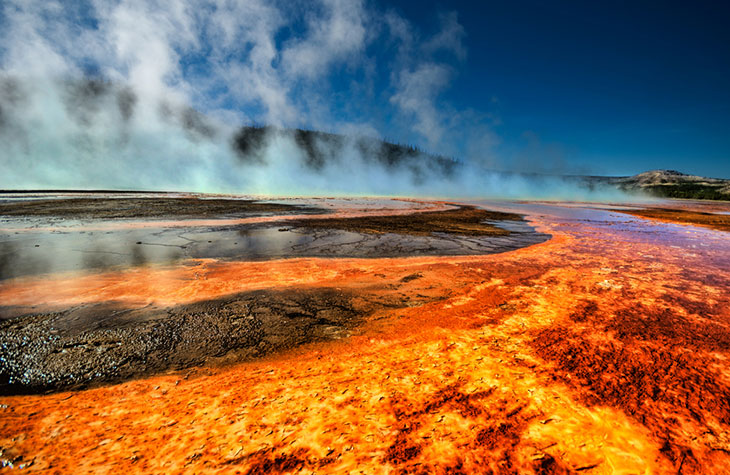Viruses Find Love In A Boiling Place

The colors of Yellowstone's hot springs come from microbes called thermophiles, which flourish in the boiling water.
(Inside Science) -- Terrestrial life can exist in extraordinary environments: In the dark, crushing depths of ocean trenches, in the frozen lakes of Antarctica. Biologists now have begun studying life in what may be in the most extraordinary realm of all, life that thrives in boiling acid hot springs.
The life forms are lesser-known species of microbes called archaea that, biologists agree, are "peculiar."
One of those biologists, Mark Young, a structural biologist and professor of biology at Montana State University in Bozeman, finds his samples in Yellowstone National Park, about 90 miles away. Out of sight from the thousands of tourists, Young and his researchers collect the archaea out of the springs to study the viruses that infect them. Besides being unique, the viruses help describe the mechanism of evolution and may even have medical uses.
The Yellowstone viruses were unknown a year ago. They reside in springs with temperatures recorded above 175 degrees Fahrenheit. The springs are more acidic than battery acid. There are thousands of such springs in the park.
Viruses do more than cause disease. They are critical for evolution, Young said, because they move genes around quickly to their hosts, altering them. Much of the study of genetics involves studying viruses, he said.
"If you remove viruses from the equation of evolution would evolution be different?" Young asked. "Absolutely yes."
"They are the central agents for driving life on this planet," he said. Organisms that host viruses, including humans, are what they are because of viruses.
One example is the mammalian placenta. Placenta cells derive from genes transmitted though viruses, Young said. There would be no mammals on Earth without that transmission.
"Viruses are everywhere in all kinds of environments," said David Prangishvili, a virologist at the Pasteur Institute in Paris, who also studies them. Young and Prangishvili run two of the leading centers for studying the hot spring viruses.
Wherever cells grow, there are viruses, he said.
The study of the viruses stems from a revolution in biology that happened at the end of the last century. Biologists changed the taxonomy of organisms to divide life into three domains or kingdoms: eukaryote, which are creatures made of cells with nuclei contained in cell walls, bacteria, and archaea, organisms about the size of bacteria but that have no cell nucleus or walls. Humans are eukaryotes.
The hot springs viruses use archaea as hosts. Neither the viruses nor their host species are found anyplace other than the boiling springs.
Young said he knew there was life in the hot springs and suspected it was archaea. He found, indeed, that archaea was the only life form he initially found in the springs. He assumed there had to be viruses associated with the archaea and found them as well. They are completely different from any viruses ever seen before elsewhere.
"To me, that was a bonanza," he said.
Prangishvili said these viruses vary among themselves and have unique genomes.
Young's research is local. Yellowstone is an hour and a half from Bozeman ("shorter before Montana imposed a highway speed limit," Young said.)
At first, he took samples back to the lab to study but now has the technology to assess them in the field. Letting them cool down is actually a benefit. When they are heated up again, they work at least as well as they did originally. Like a good stew, they seem to be better the next day.
While the study has produced a valuable tool to study viruses, there are practical spinoffs, he said.
For instance, viruses essentially have the shape of molecular-sized coffee cups, with a protein shell and nucleic acid on the inside.
If the inside of the virus was extracted, the outer shell would still retain the properties of the virus, the shell still would still know what cells to interact with, making it a vessel for delivering the drugs to "cells you care about, like cancer cells," where it would be needed.
Because they come from thermal environments, they are stable. The products of the procedure produce what are called constrained reaction vessels.
Also, viruses have to both get in and get out of cells. The archaeal viruses have a unique way of doing that, he said. They build a seven-sided structure on the surface of the cell that opens like flower petals, creating a hole through which the viruses exit.
"It's really cool," he said.
He found the process was controlled by a viral protein and it could be put in any cell you want, making an antibiotic, by opening or closing the cells at will.
Pangishvili said no one knows why the viruses live in these conditions except that that's where their hosts dwell.
They are just biochemically peculiar, he said.

